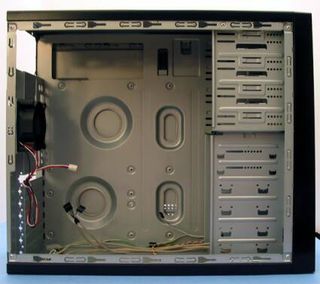2003 Winter Case Review Part 2: The ATX Avalanche
Athenatech: 400 Series, Continued
Athenatech is focusing on the integrator/value segment of the market with the 400 Series. This case is almost a return to the past with a semi-attractive front bezel reminiscent of the Dell XPS. Athenatech is looking to make a good impression with the front bezel, but does not follow through with this value oriented offering that weighs next to nothing. While the construction of this case is fair for a case of this type, it certainly is not stellar when compared to other cases in its genre within this review. Still, there is unquestionably a market out there that wants a value price with an attractive quality look that will keep buyers interested.
Athenatech foregoes many of the normal bells and whistles that we have found in other Athenatech cases, instead opting for a straight ahead value approach that certainly looks out of place when compared to the other quality standards of cases presented elsewhere in this review. If you want sharp edges, you can find them here. This case is hard tooled and has riveted construction that exhibited very little bend and very little twist in our testing; but the inner rolled edges were often sharp.

A look at the inside of the 400 Series.
We found the 400 Series quite cramped inside. We were able to install our test system with very little difficulty, even though Athenatech again failed to provide any comprehensive instructions or documentation for this 400 Series case. In the testing configuration that we received from Athenatech, the case requires only one 80mm fan, but it did include the side panel air guide. What is more puzzling, though, is that Athenatech did not even bother to include the 80mm fan in the front of the case that is used for intake. The cooling potential of this case was average, but it definitely is not targeted at the overclocker, enthusiast market space. It did run somewhat hotter than the other cases we tested. We are not exactly certain why this was, but it could partly be due to the position of the air guide in relation to the rear exhaust fan, which obstructs some of the airflow from front to rear of the case. After removing the air guide and replacing it with another 80mm fan, our results did improve somewhat.
The plastic bezel of the 400 Series is quite attractive. It gives this case an interesting, yet elegant, appearance, particularly with the power switch located near the center. The finish of the case is adequate, but not stellar. While we did not see any evidence of problems with the painted finish, we were not overly enthused by the quality of the black paint that was used for the side panels and top of the case. For a value proposition, however, the 400 series is probably quite suitable.
Stay On the Cutting Edge: Get the Tom's Hardware Newsletter
Join the experts who read Tom's Hardware for the inside track on enthusiast PC tech news — and have for over 25 years. We'll send breaking news and in-depth reviews of CPUs, GPUs, AI, maker hardware and more straight to your inbox.
Current page: Athenatech: 400 Series, Continued
Prev Page Athenatech: 400 Series Next Page Athenatech: 400 Series, ContinuedMost Popular



